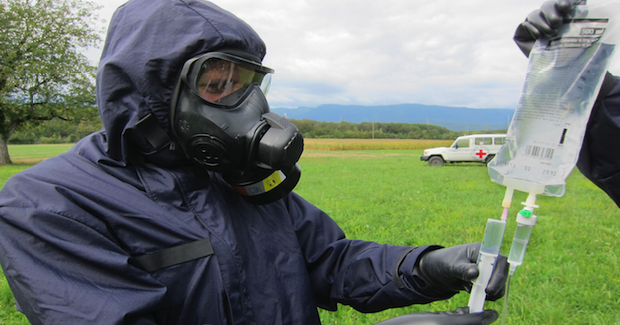Preparing for a Biological Weapons Attack

The recent outbreaks of disease across the developing world have provided a valuable lesson in the harm that could be caused by a biological weapons attack. Preparation and regulation are key to mitigating the humanitarian effect of weapons of mass destruction.
When the Ebola virus swept through West Africa in 2014/2015 it created panic on a global scale. States and humanitarian agencies scrambled to respond to the threat; borders were closed and movement was restricted in an effort to contain what became the worst outbreak of the disease in recorded history.
By March 2016, the World Health Organization had declared the pandemic over, but not before the disease had taken the lives of more than 11,300 people, and infected an additional 17,300 others.
The race to contain Ebola taught us a number of important lessons. As a health emergency that spread across borders, it required action from a diversity of actors, from multiple states and their militaries to local and international humanitarian organisations. It was a massive effort that tested the strength and efficiency of the global response system for public health emergencies—and, unfortunately, it came up wanting.
The post-mortem of the Ebola experience raises a number of critical questions that must be answered if we are to improve our ability to respond to a major outbreak of disease.
Namely, which organisations will be involved in mounting a global response to a pandemic? What are their different roles, including those of humanitarian organisations? How should the international response be coordinated? And how would it be triggered?
For the International Committee of the Red Cross (ICRC), an organisation mandated to provide humanitarian assistance in situations of war and internal strife, the Ebola experience also brings into the spotlight enduring questions about the international community’s preparedness to address another—potentially much more complicated—scenario.
Specifically, how would we deal with a situation where a deadly virus or bacteria is deliberately spread?
Biological warfare is nothing new—historians have documented instances where medieval armies threw Black Death-infected cadavers over city walls to wipe out enemy populations and during the post-World War II period several of the major powers had significant military biological weapons programs. However we have yet to agree on a way to work together to respond to a potential biological weapons attack.
We saw the complexities involved in dealing with a naturally occurring pandemic in countries not experiencing active conflict. In the case of a deliberate outbreak of a disease in a war zone, the political and security sensitives are likely to further complicate any attempts to respond.
Governments know we are ill-prepared to mount an international response. It was a significant point raised at the recent review conference on the Biological and Toxin Weapons Convention (BWC), held in November this year. The ICRC used the meeting to raise the alarm, calling on states to establish a process to agree on how to strengthen the global response capacity to a biological weapons attack.
Unfortunately, the conference ended in failure to adopt any new program of work for 2017.
It’s time to take this issue seriously. It has been more than 90 years since we came together to ban bacteriological methods of warfare. Their use was first outlawed by the 1925 Geneva Protocol, and then later the 1972 BWC completely prohibited their development, production, stockpiling, and transfer. The ban on the use of biological weapons is absolute and far-reaching. It is part of customary international humanitarian law, which is binding on all those fighting in armed conflicts, whether they be states or non-state armed groups.
Yet, even after the 1972 ban, some governments still worked to turn germs into deadly weapons. Anthrax, the plague and toxins have all been weaponised. And we know that armed groups and criminals have also attempted to spread disease.
Scientists have pointed out that technological barriers to developing and using biological weapons have been significantly lowered in recent years. Future scientific and technological advances could make biological weapons cheaper to obtain, easier to use, deadlier in their effects and harder to detect.
The ICRC reiterates its call to states to work together to develop and agree on practical actions that would help increase preparedness to deal with a biological weapons attack. Among other things, this must involve building response capacity where it is lacking and improving coordination among actors who may be involved in a response. This would be aided by better mapping the current capacity, limits, roles, mandates and working methods of relevant organisations in order to avoid unnecessary duplication and ensure better harmonisation during an emergency.
The deliberate release of a deadly disease in a war zone could lead to suffering that does not bear thinking about. Facing a fatal disease in a country where security and medical care is guaranteed is horrifying enough. We know that those who were struck down by Ebola faced the most isolating and frightening of experiences.
Responding to their plight taught us critical lessons that we cannot afford to ignore.
Andrea Lunt is the communications officer at the International Committee of the Red Cross (ICRC) Australia Mission.
This article is published under a Creative Commons Licence and may be republished with attribution.





